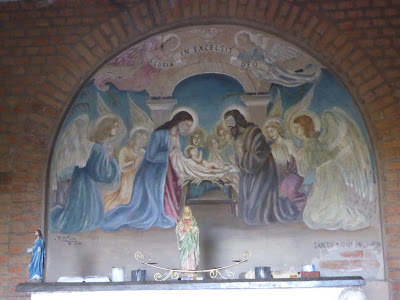Annamaria on Monday
Perhaps they did it out religious fervor. Perhaps out of homesickness for their faraway land that boasts fabulously beautiful churches in every corner of the country. Perhaps because so many Italians seem to be compulsive builders of beautiful buildings and makers of art. This I know for sure: during World War II, Italian prisoners found ways to express all three of these motivations by building tiny churches on three continents!
Africa: Kenya
Stats: 55,000 POWs in eleven camps. (BTW, there were only 21,500 British subjects in Kenya at the time!)
Mai Mahiu
I’ve previously given you a glimpse of this one, which I have seen in person, thanks to an Uber driver. This tiny church was built by Italian prisoners in 1942. They had constructed a corniche road overlooking the Rift Valley between Nairobi and Naivasha and asked for permission to build it in gratitude for having completed the dangerous project without injury. It is positively beautiful.
Ndarugu
In researching today, I discovered that there is second tiny chapel in Kenya, near Thika of Flame Tree fame. There, prisoners were put to work on coffee plantations and dairy farms. They also made bricks, but they built their tiny church of stone they themselves quarried. It seats sixty.
Great Britain
Scotland
This beauty is on the Orkney Island of Lamb Holm, which housed 500 POWs. It’s only 16 feet wide and 72 feet long. Like all these structures, the prisoners’ materials of construction were whatever they could scrounge from the environment.
As to motivation, one of the builders of this absolute gem is quoted as saying, “It was the wish to show to oneself, that in spite of being trapped in a barbed wire camp, down in spirit physically and morally deprived of many things, one could still find something inside that could be set free.”
Wales
Henllan
The exterior here is just a (now restored) Quonset hut. The artist who did the painting—Mario Ferlito—was self-taught because his parents were too poor to pay for art school. He was one of 1200 Italian POWs in this remote village in north Wales. They made the paint by boiling fish bones to make an adhesive and mixing in pigments made with fruit, vegetables and tea leaves.
The United States
Franklin, Indiana
Some of the 3000 POWs, built this tiny chapel in rural Indiana out of leftover brick and stucco. They decorated it with paint pigmented with flowers and berries from the local swamp and their own blood.
They also volunteered to decorate the local Catholic church, which—while beautifully constructed—was until then without interior ornamentation.
Camp Hereford, Texas
The 79 POWs in this Texas town cobbled together enough materials to build this little gem.
VIVA!!



































Wonderful recognition of the human spirit.
ReplyDeleteThank you, Michael. These stories struck exactly that chord with me. Perhaps, right now, we all need to find our own little version of that spirit and do beautiful little things. I hope ours can reverberate through future decades the way these monuments do.
DeleteI wonder how many, after the war, stayed on in the communities where they did their work rather than repatriate.
ReplyDeleteMy research said, in Britain some did, but I am not sure how they arranged that. In NJ they did not have to build their own churches since there were plenty of Catholic houses of worship to go around, and they were welcomed to the Italian American communities. Some of them even came from the same home villages as the local immigrants. People got news of their loved ones in the old country--more up to date than they had had because there had been no mail from Italy for many years. I Knew of two couples where a Jersey girl and POW had fallen in love. But the POWs were forced to repatriate. After the war, their ladies went to Italy, married them there, came home and jumped through the many hoops to bring them back. It took more than a year.
Delete